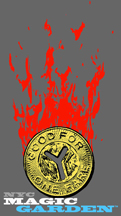
Home
Can I Come?
Calendar
Photos
Links & Classifieds
Be Nice Campaign
Passwords
Past Invites
Press
Contact
MOVIN
ON UP MAGIC Just like the Jeffersons, the MAGIC GARDEN is movin on up to the East Side. This is an exciting change, as we've never done a party in this neck of the woods. As a special treat, we're spicing it up with free food! Yes, FREE FOOD! So come from work, or from school, or from robbing the liquor store, and eat, drink and talk about day camp. Same great drink specials ($3 Rheingold, $4 Staten Island Fairy, Roosevelt Island Tramp, and Ghetto Blaster), same great DJ (Justin Cheatham, aka DJ SLY), and same great friggin city. "Have a summer of fun in the Poconos. We're your host with the most in the Poconos. Beautiful Mount Airy Lodge." While we all know Mount Airy Lodge was not in NYC, the advertising campaign was directed towards us, NYC taxpayers who might be willing to spend their hard earned money to wade in a heart shaped tub. How romantical! Mount Airy Lodge closed in 2001, and on March 5 and 6, the owners will be auctioning off the contents of the resort - http://www.teelauctions.com/Auctions/AuctionDetail.cfm?AuctionID=102 In the 1960s and 70s, the resort grossed over $50 million a year and sold more liquor than anywhere else in Pennsylvania. Lots of your favorite entertainers graced its stage, including Engelbert Humperdinck (who was born Arnold George Dorsey and later named himself after the German composer, Engelbert Humperdinck, 1854-1921, who wrote the fairytale opera “Hansel and Gretel.” I didn’t realize you could change your name on a whim like that. Please start calling me Tammy Faye Baker); Tony Bennett (born Anthony Dominick Benedetto, the son of an Italian grocer in Astoria, who got his big break when Bob Hope saw him perform in 1949 in Greenwich Village); and good ole Bob Hope (born Leslie Townes Hope in England, then moved to Cleveland when he was four). Bob Hope was a part owner of the Cleveland Indians in the early 1950s. Poconos is a Native American word meaning "stream between two mountains" - the Delaware River cuts a gap between two mountains. By the way, it is expected that the current owner of the Mount Airy Lodge may open a casino on the premises. There was once a nightclub in Central Park called the Casino, near East 66th Street, originally known as the Ladies Refreshment Salon. When Jimmy Walker was mayor, he had the club leased to a friend who redesigned it all lavish-like, and then the new fancy schmancy spot became the hub of the mayor’s social activity. After Walker’s resignation in 1932, Robert Moses, who was a political rival of Walker’s, had it torn down and replaced with a playground. We celebrated Central Park’s 150th anniversary in 2003, even though it didn’t really open until 1858. Math is hard. I was going to go into a tirade about the Gates, but I’d rather not expend precious finger to computer keyboard energy for their sake. It might’ve been cool to do a Gates-like project in the 1850s, when the area that is now home to Central Park consisted mainly of shantytowns. About 1600 residents were displaced for the building of Central Park, including inhabitants of Harsenville, the Piggery District, and the Convent of the Sisters of Charity. These settlements included schools, churches, cemeteries, shops, and public hospitals. But the most significant community was Seneca Village – not a hamlet for “the first frozen apple juice enriched with vitamin C” (c’mon, you remember the jingle from the commercials) – but a settlement in a rocky area from 81st to 89th Streets between 7th and 8th Avenues. By 1853, Seneca Village was a thriving community: two thirds African American and one third Irish and German, and by 1858 there wasn’t a trace left. Seneca Village is so important because it was probably Manhattan's first prominent community of African American property owners. Seneca Village indisputably started after slavery ended in NY in 1827. While this gave African Americans their long-awaited freedom, it didn’t automatically give them the right to vote. According to the New York State Constitution of 1821, African American males were allowed to vote only if they owned $250 in property. And so moving uptown made sense – African Americans could own property that would have been too expensive downtown. (Never take voting for granted.) Within a few years, the community was comprised of about 250 working-class people, with African Americans owning more than half the property. The Irish potato famine brought many Irish immigrants to the United States; many moved to Seneca Village and rented or bought land from African Americans. It became a fairly peaceable ad harmonious interracial community, with two schools, three churches, and three cemeteries. There are many theories about how Seneca Village got its name: possibly named for the Seneca tribe of Native Americans, or a distortion of the word “Senegal,” where many of the residents may have come from. It also may have been a code word used by Underground Railroad fugitives, or an homage to Roman philosopher Lucius Annaeus Seneca (4BC-6AD), whose book “Seneca’s Morals” was popular among African American activists. When the plans to
build Central Park were put into effect, power of eminent domain was used
– a 5th Amendment detail allowing the government to take away private
property for public use - to evict the
residents. Those who owned property were modestly compensated. By 1857,
nothing was left of Seneca Village. There was no establishment of a new
community and the villagers scattered throughout the city. But we did
get Central Park. Enjoy your neighborhoods, because Christo may want to
drape and smother them someday. |